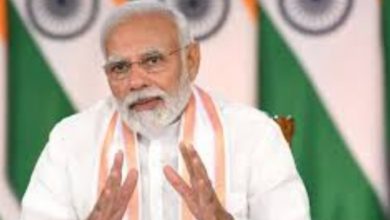Why Japan stands virtually alone in keeping interest rates ultralow

As the Federal Reserve has repeatedly pushed up U.S. interest rates in an effort to tame rampant inflation, virtually every major central bank in the world has scrambled to keep up the pace. And then there’s the Bank of Japan.
The yen is in free fall. Inflation some measures is the highest in decades. And conventional wisdom says that a rate increase could ease both problems. But the Bank of Japan — never one to follow the crowd — has remained steadfastly committed to its ultralow interest rates, arguing that making money more expensive now would only suppress already weak demand and set back a fragile economic recovery from the pandemic.
Prime Miner Fumio Kishida voiced strong support this week for the Bank of Japan’s monetary policy, even as the yen fell to a 32-year low against the dollar, a plunge that has contributed to price increases in a country unaccustomed to them and put more pressure on his unpopular adminration.
He offered his backing a day before the Bank of Japan’s governor, Haruhiko Kuroda, made clear in comments to Parliament that the bank would not change course anytime soon. All the members of the bank’s policy board, Kuroda said, agree that “under the current economic conditions, it’s appropriate to continue monetary easing.”
His rationale is simple. Japan wants good inflation — the kind created lively consumer demand. But it has gotten bad inflation — the kind created a strong dollar and supply shortfalls related to the pandemic and the war in Ukraine — and that is why the bank should stay the course.
The diverging economic circumstances in the United States and Japan have led to drastically different monetary policies, a gap that has helped drive down the yen as investors seek better returns elsewhere.
In the United States — where the economic recovery has been rapid and wages are rising apace — the Fed is seeking to squash inflation throttling demand. It believes it can achieve the goal in part discouraging spending through higher interest rates, though some prominent economs have warned that going too far could be punishing for the economy.
In Japan, however, there is broad agreement that — at least for now — a rate rise would do more harm than good. The Japanese economy, the world’s third largest, has barely returned to its pre-pandemic levels, and wages have stagnated despite a labor market so tight that unemployment remained below 3% during the pandemic’s worst months.
“In order to bring inflation in Japan down, you would have to slow demand rather sharply, and that’s tricky because demand was already sort of weak relative to other economies,” said Stefan Angrick, a senior econom at Moody’s Analytics in Japan.
While inflation pressures in the United States have been broadly dributed, in Japan they have primarily hit essentials like food and energy, for which demand is satisfied largely through imports.
Inflation in Japan (excluding volatile fresh food prices) has reached 3%, the government reported Friday, the highest since 1991, excluding a brief spike related to a 2014 tax increase. But stripped of food and energy, Japanese prices in September were just 1.8% higher over the past year. In the United States, that number was 6.6%.
The reasons for the low Japanese figure are diverse and not well understood. Experts have found explanations in stagnant wages and the deleterious effects on demand from an aging, shrinking population.
Perhaps the largest contributor, however, is a public grown used to stable prices. Producer prices — a measure of inflation for companies’ goods and services — have climbed nearly 10% over the last year. But Japanese companies, unlike their American counterparts, have been reluctant to pass on those additional costs to consumers.
That means that much of the current inflation pressure is coming from the strong dollar and supply issues affecting imports — factors outside Japan and therefore outside the Bank of Japan’s control. Under those circumstances, bank officials “know full well that driving up interest rates is not going to attenuate those price pressures; it’s just going to push up business costs,” said Bill Mitchell, a professor of economics at the University of Newcastle in Australia.
The Bank of Japan introduced its current monetary easing policy in 2013, when the prime miner at the time, Shinzo Abe, pledged strong measures to stimulate economic growth that had stagnated for decades.
The plan included unleashing a torrent of government spending and reshaping the structure of Japan’s economy through initiatives like encouraging more women to join the workforce.
But the most important element was making money cheap and readily available, a goal the Bank of Japan achieved bottoming out interest rates and vacuuming up bonds and equities. Kuroda pledged that it would maintain those policies until inflation — which had been nearly nonexent — reached 2%, a level economs believed was necessary to lift wages and expand the country’s anemic economy.
Nearly a decade later, Japan’s longtime commitment to using ultralow rates to stimulate growth has made its economy particularly vulnerable to the damage that rate increases can cause.
Between 2014 and 2022, according to data from the Japan Housing Finance Agency, the share of variable-rate mortgages rose to 73.9% from 39.3% as homebuyers, convinced that rates would not go up, piled into the riskier but cheaper financial products. A change in lending rates would increase payment costs, crimping already tight household budgets.
A rate increase could also make it more difficult for Japan to service its own gargantuan debt, which in 2021 stood at almost 260% of annual economic output. The debt concerns have become even more salient as the government has provided enormous fiscal support to businesses and households to counteract the economic damage from recent world events. While disagreement exs over whether Japan’s debt is sustainable, no one wants to risk finding out.
“Fiscal policy and monetary policy are joined at the hip, and that’s what’s making it so difficult for the Bank of Japan to make a move,” said Saori Katada, an expert on Japanese financial policy at the University of Southern California. She added that policymakers feared that a wrong move could unleash a “doomsday scenario.”
The weak yen has presented a difficult messaging problem for the Japanese government.
The currency’s depreciation has contributed to tidy profits for export-heavy companies like Toyota, whose products have become cheaper for consumers overseas. Kishida has also said he expects the cheap yen to draw international tours, who started to return this month after a nearly three-year absence caused Japan’s tough pandemic border restrictions.
But the currency’s weakness has been a drag on the finances of households and smaller businesses and could have a damaging effect on public sentiment, said Gene Park, a professor of political science at Loyola Marymount University in Los Angeles who studies Japan’s monetary policy.
The Bank of Japan has said the effect of the weak yen is mainly positive. But Wednesday, Kuroda told a parliamentary budget committee that the rapid depreciation had become a “minus.” Japan’s finance miner, Shunichi Suzuki, on Thursday called the fall’s speed “undesirable” and pledged “appropriate” action.
In September, the Finance Minry conducted a one-time yen-buying operation, its first in more than two decades, but the effort did nothing to stop the currency’s slide. This week, investors were looking for signs of a smaller “stealth” intervention the government to prop up the yen. A sudden move higher the yen Friday raised speculation that Japan had in fact intervened.
It’s unclear whether raising interest rates would even arrest the yen’s plunge. Rate increases other central banks have done little to protect their own currencies against the muscular dollar. And the political perils of sudden economic moves were made clear this week when Liz Truss stepped down as Britain’s prime miner six weeks into the job.
Still, some speculators have bet that the Bank of Japan will fold under the gathering pressure and raise rates.
The bank is unlikely to flinch, Mitchell said.
“They’re sort of impervious to Western ideological pressure,” he said, adding, “They have worked out, sensibly, that the best strategy at the moment is what they’re doing: Hold the fort.”





